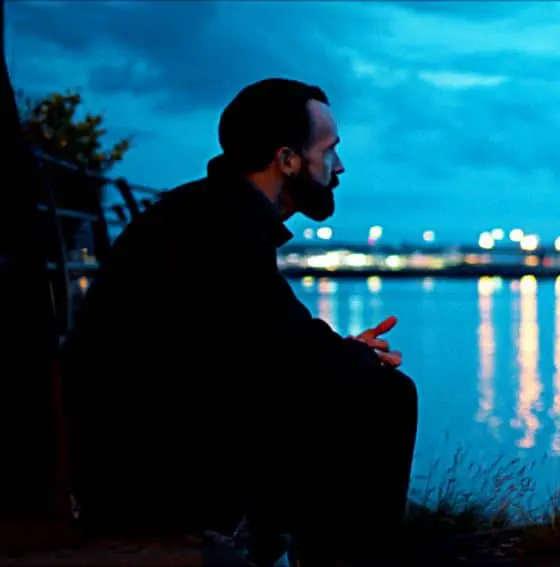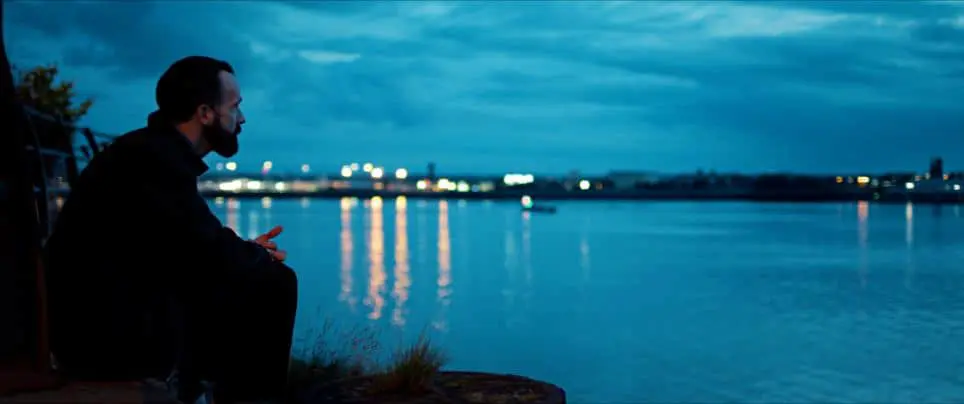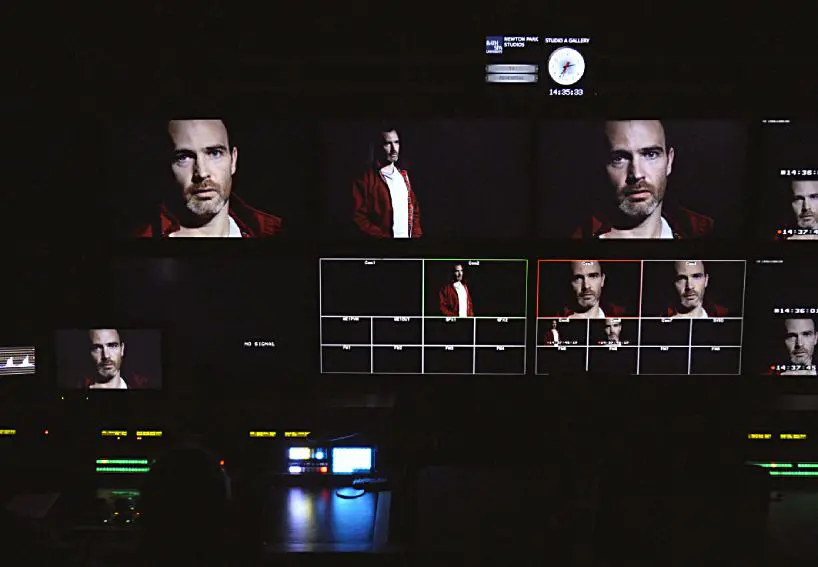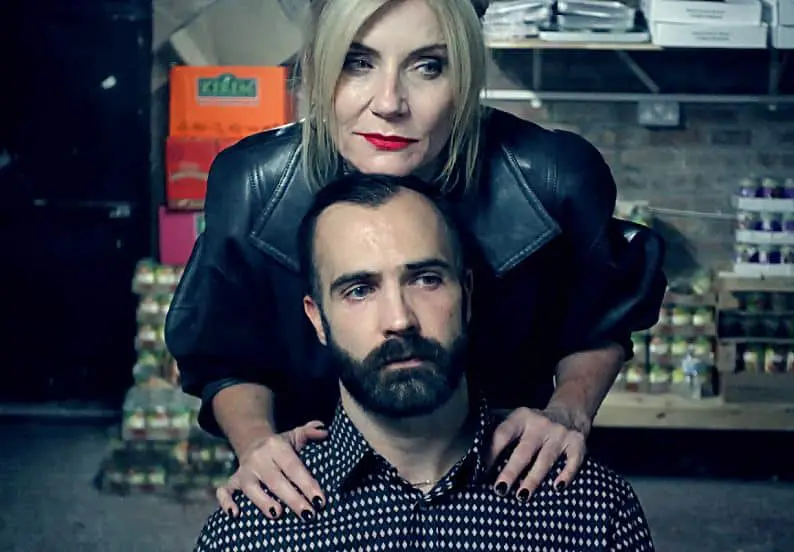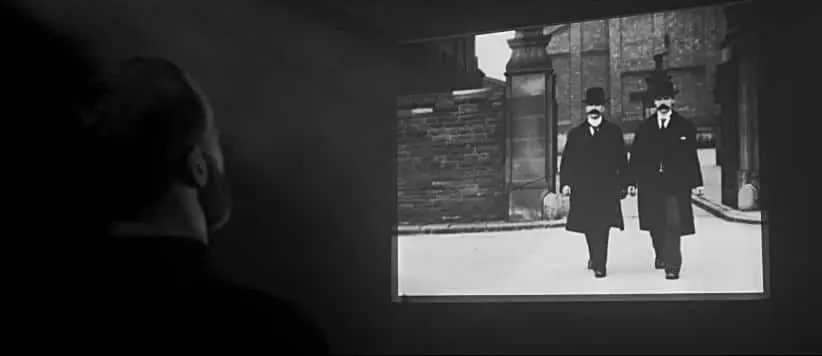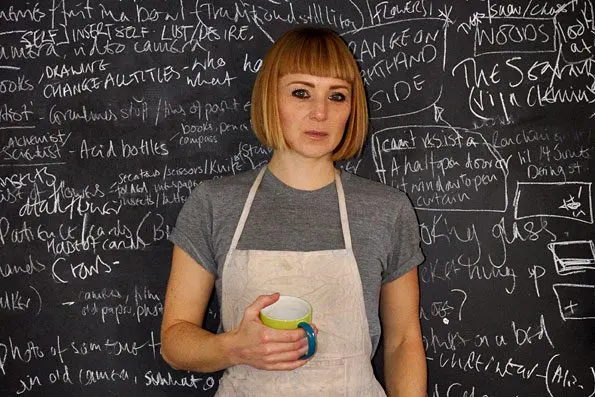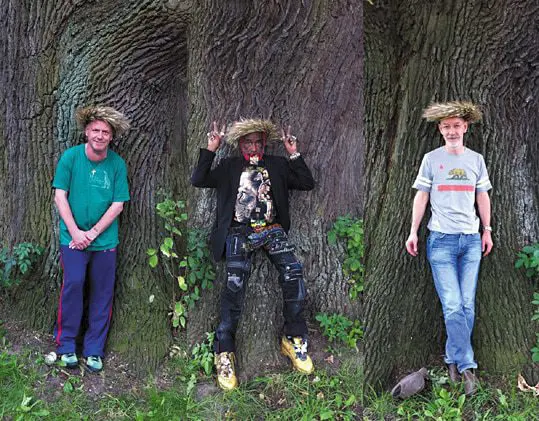words Lee Taylor
When I first read about the film Stephen I was intrigued and a bit puzzled. It threw up a lot of questions and some troubling memories. On the surface it was a film by the artist Melanie Manchot about addiction. But the more I read about it and thought about it the fascinating layers began to emerge.
I have to say at this point that I myself have struggled with addiction to alcohol and quite severe mental health issues. In my mid twenties I was in a bad way. Something inside me somehow managed to manifest itself and pull me back from the dark pit I found myself in.
The interesting thing about the film is that Stephen is the lead character but he’s played by Stephen who had been addicted to alcohol himself. Melanie met Stephen a few years back when making a video installation about addiction. That’s where she met Stephen through a recovery facility. Stephen seemed to transform in front of the camera. He went on to study acting for a time but almost gave up. Melanie wrote the film Stephen for him.
In my mind alarm bells were a ringing. Could involving addicts in video art and films help or hinder them? Could it be seen as a kind of victim porn, watching struggling people for entertainment? It must have been a delicate balancing act for the artist avoiding falling into the many traps that lay in wait. Melanie though I discovered liked and respected Stephen as he did her. That respect and friendship enabled Melanie to create a sensitive and challenging film.
The artist and filmmaker as I found out also struggled with these dilemmas and more. I decided to ask them both a set of questions. That way I could best delve deep into the film itself and its main character, Stephen himself. The answers I got back from both were moving and thought provoking. These first answers are from Melanie.
When and where did you first meet Stephen?
We met in January 2013, in the course of working towards a video installation I produced at the time, called Twelve. Twelve was created over a period of two years with twelve people in early stages of recovery from long-term substance misuse, many of them barely two weeks clean and sober. Stephen was one of a group of people in a recovery facility called Sharp in Liverpool who joined the project. We worked through an extended period of workshops, and he became possibly the most central participant and most present character in the multi-channel video.
What first struck you about him as a person?
When I first met Stephen, he was incredibly young to go into full recovery – often people still have a long way to go before they decide that they have hit rock bottom. With Stephen, the issue was perhaps less his actual relationship to alcohol, it was much more to do with his mental health which had arrived at a critical point – and this in turn brought him into a place, where he could find help.
When I first met Stephen, he immediately struck me as a compelling person, there is a lot of energy, complexity and intensity in him but he is also very funny, sharp witted and a naturally gifted storyteller. He can light up a room.
For me what was perhaps the most phenomenal was how he took to being in front of a camera:
Every time the camera turned on this ‘other’ Stephen emerged: incredibly present, engaged, empathetic and charismatic – it was as if he became lighter and brighter. Other people noticed it too. It was stunning to see the transformation that the camera seemed to facilitate, how it called forth multiple other versions of ‘being Stephen’, how it gave space for him to produce and experience aspects of his complex character that without camera stayed hidden. I often speak about cameras as tools that facilitate moments of fabulation, of being both self and ‘other’. For me, cameras are less about creating images, they are more important as tools that create relations, operating like an organising principle that allows for situations to emerge, which could not exist without a camera.
When and why did you first become interested in addiction as a topic?
In 2011, I received an invitation to consider working on a project ‘about addiction and recovery’, extended by curator Mark Prest who has lived experience of addiction and now runs an organisation called PoRe, Portraits of Recovery, dedicated to the intersection of art, mental health and addiction recovery.
https://www.portraitsofrecovery.org.uk
At the time, I was immediately intrigued but also apprehensive: there are big ethical questions to negotiate on whether and how I could make work that avoided the substantial pitfalls, clichés and stereotypes attached to addictions – the seesaw of vilification and glorification of drug use. It was very important to me to question whether I could make work WITH and not ABOUT people suffering with addictions. This is especially pertinent as I don’t have first-hand lived experience of addiction within myself. (see also below)
Have you had any experience of addiction in your own life?
My experiences of addiction have been through other people, close friends and one person in my family. I would say I have lived with the additions of others but have not experienced any of the traditional forms of substance misuse myself. However, I feel strongly that most of us could potentially succumb to an addiction, especially if painful or traumatic events shape one’s life or create a rupture. One of the poignant understandings I have gained by working with the subject is that addictions cross all perceived borders or boundaries, whether those of class, economic status, cultural background…
What first gave you the idea to make this film?
The film has a fairly long gestation and back story, starting with meeting Stephen as mentioned above and realising what a powerful presence he has on camera. A few months after the conclusion to the workshops in 2013, he revealed that he had decided to join a drama school as he loved the experience of acting – and had also perhaps slowly started to admit to himself that he is good at it, that he has something to give.
Fast forward another two years and Stephen is working with a great coach but decides that he will stop, he doesn’t believe it will ‘happen for him’; instead he wants to go to university and start studying to become a mental health nurse. But he says, perhaps flippantly:
“If only once in my life I would have the opportunity to act in a proper film, if only once I could show the world what I’ve got in me, what I might be able to do as an actor – then either I can lay it to rest or who knows… something might come off it…”
I am so convinced of his talent, he is a very gifted, special person and actor and it felt that this needed to have a chance to shine… so I said to him: “Ok, I will write that film.”
This was the start, about seven years ago.
The process then evolved through a significant period of research, in particular into the history of film specific to Liverpool, where Stephen is from and where he lives. It was evident from the start that the film would need to be set there and be anchored by locational research. My process often proceeds through relational and locational references, building a framework in which to develop ideas.
In the case of STEPHEN, this research very quickly presented me with the first film ever made in Liverpool, a BFI archive gem called ‘Arrest of Goudie’. This beautiful 7-minute film is also, significantly, the first ever crime reconstruction – based on the real-life arrest of a bank clerk, Thomas Goudie, for embezzling £170,000.00 from the bank of Liverpool where he worked. This is a lot of money to syphon off, especially if you consider that in today’s money this represents £22mio.
Further research presented the backstory of Thomas Goudie and his reason for this substantial fraud: he was a gambling addict. This was one of those very special moments when you realise that strands of research and ideas are coming together to create a productive web of connections: here I am working with someone whose entire life had been marked by addictions, in himself and others. And the first film in his hometown is about addiction. I immediately thought that it could be powerful to ask Stephen to take on the role of a contemporary version of the Thomas Goudie character, using his lived experience to re-enact those of a gambling addict.
Why did you want to work with real people who have faced problems with addiction themselves?
There are many reasons why it is important to the film’s meanings in both content and form that we worked with ‘real people’, non-professional actors with lived experience of addiction and their journeys of recovery. The cast is in fact made up of 16 non-pro and 4 professional actors, yet those also have experience of addiction and issues of mental health and neurodiversity. Our casting process consisted of bringing together a self-selecting group from the recovery community in Liverpool with actors who had empathy and experience of the issues the film addresses.
The film always set out to speak with people, not about them; to speak from within the central issues, not form a theory about them. Hence it needed to be informed by the lived experience of people who would bring their real lives to animating all the aspects of this formally hybrid film.
Arguably everyone is in the film in at least three ways, in three ‘characters’:
As themselves
As an acted version of themselves
As a fictional character in the Tom Goudie story
Our entire cast drew on their own as well as on each other’s real-life experiences to bring different truths to each sections. I am very cautious about these words, i.e a ‘true or authentic performance’ as I believe that there are often multiple parallel truths, that can enrich each other in the process of people becoming personas, taking on roles, embodying characters.
The film has various semi-documentary sections, improvised and filmed as long-takes, where people speak their mind – unrehearsed, in the moment, un-scripted. These sections have often in turn informed the script, in a feedback loop between the different realities that sit alongside each other in the film.
What were the themes you wanted to tackle in the film?
As in every film, there are inevitably many so the following is not exhaustive, but perhaps these are the most important:
– Find new methods to address addiction and recovery that contributes to their de-stigmatisation.
Talk about gambling as an addiction of equal severity to other, more recognised forms of addiction.
Explore formal opportunities to make a film-within-a-film that combines different genre and languages. Work in a genre bending manner to find a language that is unique to this film.
Explore the collective creativity at the heart of filmmaking for its potential as a tool in recovery and a benefit to those suffering with mental health.
While I am an artist and filmmaker, there is an underlying activism in the wider project – particularly my work with two academics at the University of Liverpool, who have been collaborating with me for the past four years. Together we are exploring new methodologies to describe the use of cameras and the process of collective creativity as a tool in recovery.
Contribute to the language of filmmaking in innovative ways.
Why did you decide to interlay footage and recreated footage of a crime that took place in 1901?
See also above. The 1901 ‘Arrest of Goudie’ serves as the perfect framework for our fiction story. In STEPHEN, the fiction is a contemporised re-enactment of a crime reconstruction. A reconstruction of a reconstruction. In fact, our Tom Goudie story is set in the 1990s, which is quite subtle – some viewers might notice, others not. I wanted to displace the re-enactment from today so that there are not only three languages: archive, fiction and documentary but also three timeframes: 1901, 1990s and now.
Do you think our addictions change our identity? Do we assume the identity of the addict, not just the addiction itself?
This is such an important but hugely complex question, which one might need an entire essay to answer properly.
So the following is running the danger of being reductive:
Addiction is an all-absorbing, totally encompassing way of living a version of self, one’s addicted identity. It might surplant and obliterate other versions of self that seem to disappear (or become temporarily hidden) as the addiction is often so powerful and pervasive. In addiction, one relationship takes over to the detriment of all others: the relation to one’s addiction, and often to the objects that pertain to each specific addiction, whether bottle, needle, screen or poker cards – these object become the primary attachment.
But there are also processes of reversal and of leaving the addict personality behind.
Have the participants themselves found making the film has changed their perception of themselves and their experiences with addiction?
Absolutely and more than they, or we all, expected. Making this film in the particular way that we worked – in this drawn out process of collective creativity – has had incredibly powerful effects on the participants. I don’t like speak for them but in post-filming interviews many of them have given strong expression to their sense that making the film has had lasting positive effects on them, on their mental health, their outlook on life, their sense of purpose. Most of all, I think we are all enthused by having made something together, by working through and with ideas collaboratively. They have variously said that they feel seen and heard, that they have been given space to be and to become, perhaps become different, explore new ways of being that serves them better.
What do you hope people will get from the film?
I would be delighted if the film reaches really broad and diverse audiences, including those who might not normally go to cinemas to see films such as this one, nor would venture into museums and galleries. Hence, we have devised an impact strategy to take the film into recovery communities, youth centres, prisons, probation centres etc. As the work will go out both through its cinematic release and as well as an installation in museums and galleries we have time to work with the care system to take the film to people – rather than necessarily expecting them to find it.
It would be amazing if the film manages to communicate a different set of ideas on addiction and contribute to the de-stigmatisation of people who suffer with addiction issues.
It would mean a lot to all of us if the film can convey a message of hope and possibility to audiences and for collective creativity to be recognised as a tool in helping people who are confronted with mental health issues and forms of addiction.
On a more general level, the film will hopefully open out ideas on the multiplicity of all our identities, how we all produce different versions of self towards different situations and relations.
And ultimately, it is a film and a work of art and I hope that audiences will feel engaged and touched by the stories the work tells – and that the film can contribute to wider conversations in film and art.
And here are the answers from Stephen himself.
Why did you want to get involved with this film?
I wanted to be involved in the film because it is something I had really wanted to do. I didn’t take an interest in acting until later in life, from where I am from it’s not really something you consider as a possible career. I did some acting classes, got into a respected acting school which I attended for some time. I then worked on some small projects and after some time I became a little disheartened and I wondered if I could actually do it. I had a conversation with Mel about how I was feeling and said I would like to maybe create my own film and create my own opportunity to work on something bigger. It was perhaps half serious as I have considered writing and it was half venting frustration.
When I got presented with the idea for this film I actually had no intentions of acting anymore. I jumped at the chance to work on the project, it was nerve wracking and also exciting. It brought a lot of self doubt to the surface as I have never considered myself an ‘actor’ but felt it was something I potentially had inside me to do. It was the ultimate test to see if I really could do what I thought and was a chance I had to take.
The subject matter was also very close to home for me so I wanted to shine a light on it and share some understanding of it if I could.
When you met the artist / filmmaker Melanie Manchot what struck you about her as a person?
When I first met Mel I just remember thinking she was kind, passionate about her work and also very passionate and curious about people. I consider myself to have strong intuition and as I got to know her I just remember thinking she was a really good person. I know lots of people are good people but for me there are a few gentle souls in this world who are very pure of heart and genuinely can do no harm to anyone else and it couldn’t even cross their mind to do so and I feel Mel is one of them. I’ve only met a few people in my life who give me this kind of energy, Kat my partner is another I have been lucky enough to meet and I feel it’s rare in the world today. As I got to know Mel my first observations were right, she is very passionate and brilliant at what she does, and she is curious about people and the world and her positive view and enthusiasm is infections.
What do you think of the idea of an artist tacking the subject of addiction?
The subject of addiction is common. It’s common in life and in art. There have been many things I have seen that have touched on the subject and it can be powerful, especially to those impacted by its consequences. I have also seen it glamorised or vilified and other times not quite true with its understanding of addiction. It’s a sensitive subject and there are many more subjects which are more delicate that have been portrayed in art. I personally just feel as with any subject which is sensitive and can potentially hurt the audience watching, you have to do justice to the subject and more importantly the real-life people who it affects.
I feel you have to stay true to it and show what it really is.
Do you think our addictions change our identity? That we assume the identity of the addict not just the addiction itself?
Addictions can change our identity in the sense that it becomes our behaviour. What we repeatedly do – we are, whether that’s good or bad. We may be good at heart but if our behaviour is consistently causing hurt then that is us — what we do then is who we are. The addiction itself brings behaviour that is the ‘identity’ of an addict, so I don’t feel we assume an addict identity but in my opinion we become it through the things we do.
This is what I feel although I think it is unique to the individual with regards to personal identity. If you assume any identity, then that is what you are to yourself. I previously identified as an addict but no longer identify with that tag. I am much more than one singular element of what makes up what I am.
Once we’ve been down that road of addiction how easy is it to slip back into that life?
I can only comment for myself. For me it was never an option to go back to any previous way of life I had. I lived in constant pain with strong desires to not be here anymore, I used external sources to numb what I felt inside and that’s how I got by. Looking back without that numbing of pain and ‘break’ from what was going on internally I may not be here. However, I knew I could only go so far with that as it was a temporary solution. I have seen others struggle but I have not had that experience. I feel if I knew back then what I know now then I wouldn’t have needed to look outside to solve anything inside. It was all a part of my journey to get me where I am with the life I have today.
How did you approach your acting for this film? Did you draw upon yourself or were you acting as a character?
From a technique perspective there wasn’t any classic approach I used. I have studied and examined methods and possibly use little parts of a mixture to what feels right and authentic for me.
I didn’t want to go into this under prepared and selling myself short. I knew I was with a cast of professional talented actors, and I couldn’t allow myself to look bad and let them down in the scenes. I practiced a lot with the lines, self-taped until I knew the lines were locked in my memory. I feel when I know the lines and what my character’s motivation is then it gives me freedom to move on the day depending on the reactions of who I am doing a scene with and what they are saying and wanting from me. I am not a professional and this was my first rodeo, but I didn’t want it to look like that.
I think subconsciously I may have drawn on previous personal experience but that wasn’t intentional, and I wanted to play the character as it had been written. It helped that we have shared experience as I could then understand what his motivations and intentions were.
How has acting helped you face up to your addictions or has it?
I don’t feel acting has helped me face any addictions. What I will say is when I was coming out of a dark period in my life and was feeling quite raw and new in the world, it helped to open my mind to possibilities that are much bigger than I had previously considered.
How did it feel playing a character who had their own struggles with addiction? Was it like playing an aspect of yourself or a character outside of yourself
I kind of touched on this previously, but playing a character with an addiction helped me have a greater insight into who he is. Tom’s experience, choices and motivation were something I could definitely identify with and understand from my own experience. It helped massively and I don’t feel as though I could have done him justice if I didn’t have that inside knowledge of what he was doing and why.
It was like playing someone who I felt very personally familiar with, almost like a family member. I could see things in him that are in me and vice versa.
What was it like seeing the finished film for the first time?
Seeing the film for the first time was something I didn’t really want to do but felt I had to. It would have been disrespectful of all the hard work people had put into it, if I did not see the final product. I was just worried I may not have done a good enough job and in turn would have let everyone else involved down.
To my surprise after I watched it, I felt good. I think this is down to all the others who I worked with, the cast and everybody who worked so hard behind the camera are so talented and I felt that showed in the final cut of the film. For my own performance I feel I done what I set out to do, I worked hard on the film and done my best in each moment. So, in that sense I feel at ease because I know I didn’t sell myself short.
What do you hope people will get from the film?
I hope people can get some insight into just how wide the net casts with one person’s addiction. There are so many people who get hurt and impacted by it. People generally assume an addiction is something an individual suffers from but its not. Anyone who loves and cares for the person in addiction has to suffer and one person’s addiction problem can become a whole family’s problem.
For others who are suffering I hope it can give some comfort that they are not alone in what they experience and others have been through it too and people do come back and so can they.
Stephen features as a MULTICHANNEL INSTALLATION: The Exchange, Penzance, Cornwall
4 May-2November 2024

